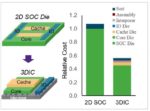Heterogeneous integration (HI) is a general term used to represent the diverse possibilities for die technology incorporated into advanced 2.5D/3D packaging. At the recent International Electron Devices Meeting (IEDM) in San Francisco, a team from Synopsys and IC Knowledge presented data from analyses of future potential… Read More
Delivering Systemic Innovation to Power the Era of SysMoore
With the slowing down of Moore’s law , the industry as a whole has been working on various ways to maintain the rate of growth and advancements. A lot has been written up about various solutions being pursued to address specific aspects. The current era is being referred to by different names, SysMoore being one that Synopsys uses.… Read More
Creative Applications of Formal at Intel
One of the sessions I enjoyed at the Synopsys Verification Day 2021 was a presentation on applying formal to a couple of non-traditional problem domains. I like talks of this kind because formal can sometimes be boxed into a limited set of applications, under-exploiting the potential of the technology. Intel have built a centralized… Read More
Synopsys Expands into Silicon Lifecycle Management
I spoke with Steve Pateras of Synopsys last week to better understand what was happening with their Silicon Lifecycle Management vision, and I was reminded of a Forbes article from last year: Never Heard of Silicon Lifecycle Management? Join the Club. At least two major EDA vendors are now using the relatively new acronym SLM, and… Read More
CDC for MBIST: Who Knew?
Now and again, I enjoy circling back to a topic on which I spent a good deal of time back in my Atrenta days – clock domain crossing analysis (CDC). This is an area that still has opportunity to surprise me at least, in this case looking at CDC analysis around MBIST logic. CDC for MBIST might seem strange. Isn’t everything in test mode synchronous… Read More
AI and ML for Sanity Regressions
You probably know the value proposition for using AI and ML (machine learning) in simulation regressions. There are lots of knobs you can tweak on a simulator, all there to help you squeeze more seconds, or minutes out of a run. If you know how to use those options. But often it’s easier to talk to your friendly AE, get a reasonable default… Read More
IBM and HPE Keynotes at Synopsys Verification Day
I have attended several past Synopsys verification events which I remember as engineering conference room, all-engineer pitches and debates. Effective but aiming for content rather than polish. This year’s event was different. First it was virtual, like most events these days, which certainly made the whole event feel more… Read More
Reliability Analysis for Mission-Critical IC design
Mission-critical IC design for segments like automotive, aerospace, defense, medical and 5G have more stringent reliability analysis requirements than consumer electronics, and entails running special simulations for the following concerns:
- Electromigration analysis
- IR drop analysis
- MOS aging
- High-sigma Monte Carlo
Why Optimizing 3DIC Designs Calls for a New Approach
The adoption of 3DIC architectures, while not new, is enjoying a surge in popularity as product developers look to their inherent advantages in performance, cost, and the ability to combine heterogeneous technologies and nodes into a single package. As designers struggle to find ways to scale with complexity and density limitations… Read More
Using Machine Learning to Improve EDA Tool Flow Results
Back in 2020 I first learned from Synopsys about how they had engineered a better way to do optimize layouts on digital designs by using machine learning techniques, instead of relying upon manual approaches. The product was named DSO.ai, standing for Design Space Optimization, and it produced a more optimal floor-plan in less… Read More










